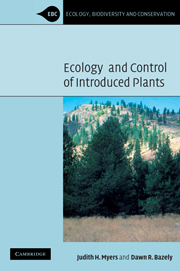Book contents
- Frontmatter
- Contents
- Preface
- 1 Introduction
- 2 Planet of Weeds: exotic plants in the landscape
- 3 Biological invasions in the context of plant communities
- 4 Predicting invasiveness from life history characteristics
- 5 Population ecology and introduced plants
- 6 Introduced plant diseases
- 7 Biological control of introduced plants
- 8 Modeling invasive plants and their control
- 9 Action against non-indigenous species
- 10 Genetically modified plants and final conclusions
- Appendix
- References
- Index
Appendix
Published online by Cambridge University Press: 02 December 2009
- Frontmatter
- Contents
- Preface
- 1 Introduction
- 2 Planet of Weeds: exotic plants in the landscape
- 3 Biological invasions in the context of plant communities
- 4 Predicting invasiveness from life history characteristics
- 5 Population ecology and introduced plants
- 6 Introduced plant diseases
- 7 Biological control of introduced plants
- 8 Modeling invasive plants and their control
- 9 Action against non-indigenous species
- 10 Genetically modified plants and final conclusions
- Appendix
- References
- Index
Summary
Introduction
The future of invasion ecology will depend on the use of good quantitative techniques. A common theme throughout this book is that data should be collected to evaluate both the extent of problems and the success of control procedures. We have included in this section a brief overview of three areas that are particularly important in the ecology of invasions: population sampling methods, measuring species diversity, and a general description of global positioning systems GPS and geographic information systems GIS. This is meant only as an introduction and we refer to other sources of more detailed coverage.
Sampling methods
The plant population ecologist has a real advantage over the animal or microbial ecologist in that, to a large degree, the target organisms stand still and can be seen and counted and reproduction and survival estimated. Of course, there are challenges with plants such as purple loosestrife, Lythrum salicaria, for which an individual may produce over a million seeds. Counting exceeds the limits of even the most patient graduate student. Sampling procedures require careful consideration and must be related to the biological question being asked. Books on ecological methods, e.g. Krebs (1999), are a godsend to the applied ecologist and new packages of statistical programs greatly simplify analysis. We will provide only a general overview here of techniques and considerations that influence sampling designs for plant ecology.
First, sampling must be done efficiently and this puts constraints on what can be done.
- Type
- Chapter
- Information
- Ecology and Control of Introduced Plants , pp. 251 - 270Publisher: Cambridge University PressPrint publication year: 2003

